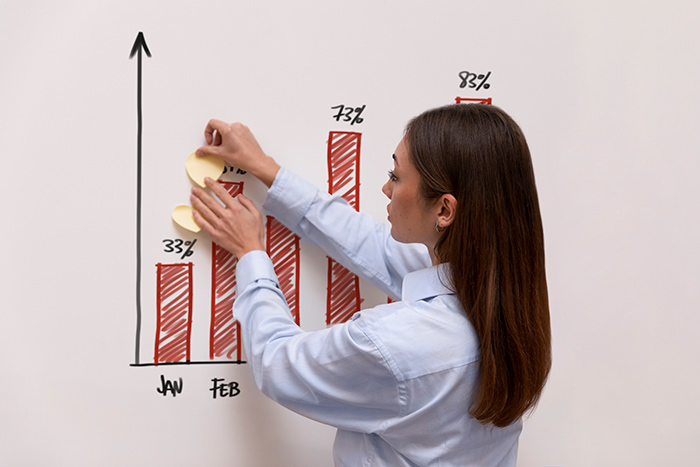The Ultimate Sales Enablement Strategy Playbook

The success and profitability of your business or company depend on how many leads you are converting to paying customers.
Your sales and marketing team is the engine of your company. And you must properly invest in them to yield performance and growth.
And that’s where sales enablement comes in. Over 75% of companies using sales enablement tools indicated nearly 40% growth.
But what is sales enablement, and how a sales enablement strategy can change the course of your business? That’s precisely what we are going to showcase today.
So let’s get started with the basics!
What Is Sales Enablement?
Let’s say, for instance, you give a specific task to a helper along with some resources to refer to for getting the job done. It’s not a brainer that, along with the right resources, your helper will find it easy to get the job done.
The same concept applies to a sales team. If you provide your reps with the right tools, resources, content, etc., they’ll be converting leads into paying customers quite efficiently.
But how can you ensure that your sales reps and marketing team are getting the right resources? The answer is a sales enablement plan or a sales enablement strategy.
According to Forrester, “Sales enablement is a strategic, ongoing process that equips all client-facing employees with the ability to consistently and systematically have a valuable conversation with the right set of customer stakeholders at each stage of the customer’s problem-solving life cycle to optimize the return on investment of the selling system.”
To put it informally and without complexity, a sales enablement model defines the right strategies, tools, content, and resources to help sales reps succeed.
But why is a sales enablement content strategy or sales enablement plan important? Let’s take a look at that in the next section.
Why Is Sales Enablement Important?
75% of companies reported that having a sales enablement strategy makes a significant impact on the company.
Sales enablement is a vital part of keeping the sales operations healthy and efficient. Why? Because over the years, the dynamics of businesses have changed. And without integrating a sales enablement plan, it’s impossible to strive in the market.
Let’s take a look at the five reasons why sales enablement is so important in today’s business environment.
Quick Access To Relevant Info
With sales enablement, sales reps get quick access to relevant info to aid the buyer’s journey.
From charts to white papers, sales reps have access to everything they need to turn a lead into a paying customer.
Without a sales enablement plan template, sales reps waste most of their time finding the right resources to help the buyer.
Everything Is Available In One Place
If a sales enablement strategy is being used in a company, reps have a single platform to access everything they need.
From training to content and analysis, everything is found in one easy accessible place.
In tools like Spinify, you can coach, train, and set out competitions for your sales reps from a single place.
Marketing & Sales Stays Aligned
Without using a sales enablement strategy, you can expect your marketing and sales departments to get misaligned at times.
However, with the right sales enablement plan in place, your marketing and sales teams stay aligned with the right resources, content, analysis, and reports.
Improves Execution, Speed, Accuracy & Consistency
What happens when all your sales reps have to do everything on their own? A great mess!
When everyone uses their own approach to aid the buyer’s journey, your company may suffer.
However, with a solid sales enablement program in place, your sales reps convert leads to customers with improved execution, speed, accuracy, and consistency.
Gradually Increases Sales

According to CSO’s insight data, “Organizations with sales enablement achieve a 49% win rate on forecasted deals, compared to 42.5% for those without.”
A sales enablement model (the right one) enables the sales reps to sell more as they have access to everything they need to win at their job.
Whether critical customer information or a mind-blowing script, they have it all. Sales enablement ENABLES the sales reps to sell more, which gradually increases the sales of the company.
That’s not all! Sales enablement has more to offer. But unfortunately, we can’t dive into the importance of a sales enablement business plan in more detail as we have more things to cover.
Now onto how you can build a robust sales enablement strategy.
How To Build A Robust Sales Enablement Strategy
A sales enablement strategy is filled with moving parts like training, tools, support, etc. And that’s why it’s essential to figure out its building blocks.
To create a robust sales enablement program, you need a step-by-step plan. And that’s exactly what we have crafted for you down below.
So let’s get right into it.
Determine Your Goals

The first and foremost thing to do when mapping out a sales enablement strategy is to determine your company’s goals.
As every organization is unique, the goals in your sales enablement strategy can differ from others. And that’s the true beauty of it; no matter what your goals are, a sales enablement strategy will help you achieve them.
Coming back to the topic, determine your goals and draft them in one place. You’ll also want to speak with the heads of other departments in your company on what needs to be done and how.
With Spinify, you can use the built-in communication tool to connect with different people from your company and ask them about the company’s goals from their perspective.
Identify Gaps in Current Content, Resources & Strategy
Once you have determined the goals, it’s time to identify gaps in current content resources and strategy.
Analyze why the current content, resources, and strategies aren’t helping your sales and marketing team to strive in the market.
Call in a meeting with the heads of sales and marketing departments and discuss how the current resources are hindering the company’s success and why.
Because once you know what’s lacking and why, you can easily fix the problems.
Take a hands-on look at the current resources, strategy, and content that’s being used by a sales rep in your company. Without a doubt, you’ll see gaps and how they should be filled.
Ensure Commitment From All Teams Involved
You have successfully nailed down the goals and gaps. But if you don’t have the commitment from the people and teams in your company, you can’t make waves.
Before you implement a change, you need to see how committed your people will be to the change.
Gather the heads of every department in your company and instruct them to analyze the perspective of employees on the change that’s about to be introduced.
Within a few days, you’ll see how committed your people are to the change you are about to introduce.
If they are excited about the change, then you are in luck. However, if there’s a mixed wave of opinions, you can use the science of gamification to change the direction of air in your preferred way.
Pick The Right Technology Stack
According to Forrester, “90% of B2B sellers don’t use sales material because it is irrelevant, outdated, and difficult to customize.”
No one likes to use software that makes their job complex–the same goes for sales reps.
You need to pick the right technology stack for streamlining the right content, strategies, communication, and more.
Without the appropriate sales enablement software, your sales reps will end up at square zero–that’s undefined.
No matter how great your goals are and how swiftly you have documented a sales enablement project plan, your company can’t win without appropriate tools.
Training & Support
It doesn’t end with picking the right tools for your sales reps. But you have to provide actionable training and support so they can use the tools to their full potential.
Your sales reps must be able to familiarize themselves with the tools quickly so they can make the most out of them in a snap.
You can train and support the sales reps either by appointing a sales enablement manager or planting special workshops and training sessions.
Last and certainly not least, show your sales reps the true value of adopting the new tools. And if that doesn’t work, incentivize the training and support program with Spinify’s gamification software.
Keep Monitoring, Optimizing & Adjusting
Now that everything is in place, you need to set up one last piece of the jigsaw in the puzzle. And that’s monitoring, optimizing, and adjusting your sales enablement action plan according to your company.
To compete with the ever-evolving sales market, you need to keep monitoring, optimizing, and adjusting your resources, tools, strategies, goals, and overall plan.
As time goes on, you’ll have to tweak your sales enablement strategy based on the new demands of the market.
Businesses who failed to monitor, optimize and adjust their sales enablement plan on the go have experienced lackluster results.
Focus on building a sales enablement strategy that grows with your business. With the right planning and execution, any business can easily revamp its ongoing sales enablement strategy without breaking a sweat.
Now that you are aware of how to build a robust sales enablement action plan, let’s discover essential components of a typical sales enablement strategy.
Essential Components Of A Sales Enablement Strategy
“84% of sales reps achieve their quotas when their employer incorporates a best-in-class sales enablement strategy.”
A standout sales enablement strategy includes the following essential components:
Sales Content
“42% of sales reps feel they don’t have enough information before making a call.”
The right content must be available to sales reps for converting leads into buyers. Sales content can include messaging guides, email templates, whitepapers, etc.
The more information, the merrier the result!
Sales Process
The sales process is the ultimate bible for a sales rep to use for converting a lead to a paying customer.
Typically, a sales process consists of five to seven steps: prospecting, approaching, presenting, handling objections, closing, and follow-up.
A sales enablement strategy that has a solid sales process can make it easier for reps to close deals successfully.
Sales Method
Many people think that the sales method and sales process are the same thing, but in reality, they are different. What is a sales method, exactly?
Sales method refers to a technique that involves skills, focus, and communication to cover a piece of sales process.
It’s a selling philosophy rather than a step-by-step guide on closing a deal.
From how to interact with the buyer and what info to present at what time, a sales method includes it all.
Training & Coaching
“26% of reps say their sales training is ineffective”.
A good sales enablement strategy must take the training and coaching of their sales reps seriously.
With the right amount of training and coaching, the sales reps get to learn the tools efficiently and use them to help the company reach new heights of success.
Without integrating training and coaching in a sales enablement plan, you can’t expect it to work flawlessly.
We have now covered a handful of valuable topics related to sales enablement. Next, it’s time to uncover some of the best practices for a sales enablement strategy.
Sales Enablement Strategy Best Practices
Adoption of sales enablement strategy in a company serves as a medium for keeping customers happy, driving revenue, and supporting selling. So, here are some best practices for your sales enablement strategy you should use to maximize its potential.
Make Sales Enablement Measurable & Transparent
A sales organization must be able to accurately measure its sales enablement strategy in use. And that’s only going to happen when a sales enablement strategy is transparent and synced with other technologies of the company.
Periodically Evolve Sales Enablement Processes
Stakeholders and the heads of a company must remain open to evolving their sales enablement processes periodically. Why? Because the market is growing at a fast pace and you can’t necessarily trust the sales enablement strategy you made several months back.
Make Salespeople Buyer-Centric
Use the sales enablement strategy planted in your company to make your salespeople more buyer-centric.
In today’s age, the ultimate power is in the hands of consumers, so why not convince your salespeople to think like them?
Set Clear Objectives
Everyone in your company must be clear on the purpose of using a sales enablement strategy.
Setting clear objectives will help everyone to stay on the same page and help the company work collaboratively and efficiently.
Key Sales Enablement Metrics & KPIs
Sales enablement metrics & KPIs can vary from company to company.
That’s why we have compiled a list of the top six KPIs and metrics used in the sales enablement space.
Here they are:
Time to Revenue
TTR or Time to Revenue refers to the average time required to close a sale. Measuring this KPI will help you to analyze how well your reps are performing.
Want to make tracking Time to Revenue fun? Use the Spinify gamification software and use the KPI feature to track the average closing time of your reps and reward them accordingly.
Lead Conversion Rate
This KPI calculates the percentage of leads that have been converted to customers. You can either track the lead conversion rate daily, weekly, monthly, or annually. It totally depends on your company’s nature.
Content Usage
Are your sales reps using the content provided by their leaders for efficiently closing deals? This metric evaluates the usage of content by your sales reps and helps you analyze individuals who aren’t using the content.
Average Win Rates
Isn’t this KPI self-explanatory? Average Win Rates refer to the ratio of closed-won deals to the total number of won and lost deals.
Number of Closed Deals
How many deals have been closed within a specific timeframe? That’s what this KPI is all about.
Here’s a pro-tip, you can use the Spinify gamification platform to track this KPI and rank your reps in a leaderboard.
Average Purchase Value
Last and certainly not least is Average Purchase Value. This very KPI refers to the overall average of how much revenue a sale brings into the company.
Conclusion
And finally, this wraps up our detailed playbook on sales enablement strategy. From what is a sales enablement strategy to creating a robust strategy and best practices, we’ve covered everything you need to be successful.
Are you looking forward to taking sales enablement to the next level? At Spinify, we are the proud creators of state-of-the-art gamification software that drives motivation and engagement in sales departments.
With Spinify, you can gamify your sales enablement pipeline without breaking a sweat. So what are you waiting for? Book a demo today and see how the science of gamification can assist your company’s sales enablement action plan.
Put those insights into practice.
Set your team up for success by improving their performance through gamification.
Back to blog







